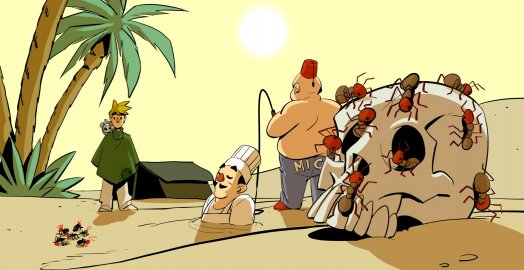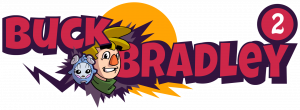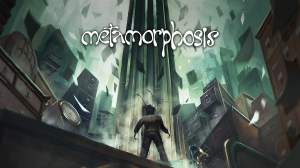Review for Buck Bradley Comic Adventure 2: The Sand and the Techno-pyramid

Save the day in an environmentally conscious way! Buck Bradley Comic Adventure 2: The Sand and the Techno-pyramid is a commercial point-and-click comic book-style follow-up to 2017’s free series debut The World to Come, and it has a few eco-friendly messages to impart as the story unfolds. Unfortunately, although the endearing art catches the eye, the gameplay is more likely to frustrate than captivate, and the comedic element misses the mark more than it hits.
For those not familiar with the first episode, the Buck Bradley Comic Adventure series is set in the polluted world of Terrastramba – so polluted, in fact, that the inhabitants have started turning into mutants. Buck’s best friend Ciroki gets infected too – in the middle of an admission of her love for Buck – turning her into a small blue dumpling-like monster with large eyelashes and pink cheeks (how else would you be able to tell she’s a female mutant?!). The pair then set off in search of a cure, and the last time we saw our heroes at the end of part one, they were on their way to New Milan, riding a train powered by the environmentally green biomethane they’d managed to produce.
Of course, their tale doesn’t end there; this episode opens in the desert with all of their new train buddies being captured by Bedouins (riding giant scorpions and brandishing clothes hangers) and forced to become slaves. It’s up to our intrepid duo to find a way to free them before setting off again for New Milan. They’ll need a lot of help from the characters they meet along the way, including some elderly folk in the nearby retirement village, and a group of pale beings dwelling underground. Plus a Nosferatu look-alike, for some reason. As you don’t talk to any of these individuals for very long, most of the lesser characters end up seeming somewhat one-dimensional. Although you do meet a few mutants too (one example being a mutated wooden pole), they seemed more inventive in the first game, which was peppered with strange creatures like the purple toucanosaur and brightly coloured dolphins splashing around in acid.
The titular Buck himself, with his Threepwood-esque hair, is not awfully likeable. He’s all for abandoning the slaves to their fate, he thinks the saying ‘beauty is in the eye of the beholder’ is a load of rubbish, and he suggests an old lady is mentally ill because she has a garden full of cacti. At least Ciroki is there to act as a sort of conscience, rebuking Buck for his nastier comments, reminding both Buck and the player of their key objectives and teaching us a little about sustainable energy. The dynamic between the two main characters is a little odd; Ciroki clearly still has the hots for Buck despite being a small fuzzy mouse-ish creature. Buck, on the other hand, is spending some of his time flirting with an attractive sewage trader (a character revisited from the first part), much to Chiroki’s annoyance.
As is no doubt clear, this is a game with an environmental theme at its heart, and it takes a brief look at the social consequences of not being more ecologically sound. New Milan, which you’ll reach in the second half of the game, consists of a giant pyramid-shaped enclosure where the powerful and rich control the dwindling energy supplies and live higher up in the fancier floors of the building, leaving the poorer folk living at the bottom in poverty. Given that Buck Bradley attempts to cover some important topics, is there anything educational or inspirational that can be taken from the experience? Pollution is bad… Fossil fuels are bad… Society is made up of haves and have-nots… It’s not as though I disagree with what the developers are trying to say, but the themes just aren’t explored in enough depth to be thought-provoking. They have, however, managed to crowbar in more information about how biogas is produced (in case you hadn’t gotten your fill from the last installment), so I can at least say I now know what the organic fraction of municipal solid waste is.
Pollution may be ugly, but the art in this game definitely isn’t. It's the same high-quality colourful cartoon style as before, with thick black outlines and some delightfully lighthearted world-building details in the background, such as an old woman doing a bit of sand-surfing and a cave ceiling covered with tuber roots. Unfortunately, there’s no animation – screens are static, with even the cutscenes being a series of comic book-style panels that you click through.
The soundtrack isn’t quite as beautiful as the graphics, but it does feel like an appropriate accompaniment to the various backdrops: Middle Eastern-style music plays in the desert area, the retirement village is complemented by a relentlessly chirpy track, and industrial-sounding electronic tunes play when you reach New Milan. There’s no voice acting, a fact that’s referenced by Buck and Ciroki several times in-game (a fair amount of fourth-wall breaking happens here).
In terms of the interface, there are some welcome improvements over the first part: the main gameplay area is larger, and in 16:9 widescreen in comparison to the blocky 4:3 aspect ratio last time. This is even referenced by Buck, who mentions it’s more “spacious” this time around. There’s still a large white border around the screen, though, which helps give the game its graphic novel feel. Another improved feature is that the cursor now turns red when hovered over an item that you can inspect or do something with.
Unfortunately, there are a number of irritating elements that remain from the first episode. Single-clicking on an interactive area in the background will provide a description of it, delivered in the form of dialogue from Buck (and sometimes other characters in the scene). All other kinds of interaction (such as talking to someone) need to be triggered by a double-click. This feels pretty awkward and clunky, as right-click (or almost anything else) would have worked far better.
Worse than this, though, is how you dismiss on-screen dialogue. When you look at or interact with something, one of two things will happen depending on what you’ve clicked on: it will either trigger a short conversation between Buck and another character (character portraits will pop up with speech bubbles you can then click through once you’ve read them), or a single speech bubble from Buck will appear. If you want to manually dismiss that single speech bubble, you’ll have to move your cursor away from the hotspot it was on before clicking, otherwise the same dialogue box will be triggered again. It might sound like I’m nitpicking, but it’s unintuitive and I ended up seeing the same dialogue over and over because of this throughout the course of the game. Those single speech bubbles do disappear on their own after a few seconds, so that’s another option to get rid of them if you’re not quite as impatient as I am.
Clicking on anything interactive will also frame that item or area of the screen with a white outline briefly, which feels unnecessary and in some cases misleading. Here’s an example: one screen has a large cactus garden in it. Clicking the cactus garden will make a large square outline appear around it, which in this case frames most of the screen. This might lead you to believe there aren’t any other items to interact with within that white outline; you’ve already clicked on it – job done, right? Wrong, that’s not true. There is in fact a single cactus within that area that can also be clicked on individually. Worse, the entire garden makes your cursor turn red (i.e. indicating it’s something you can interact with). This caused me to constantly click in different parts of interactive areas in case I’d missed something, which again led to the same dialogues being triggered multiple times. I’m just not sure what these white outlines add other than confusion.
Movement mechanics are also not great. Although you can’t move around within a screen, you move from scene to scene in a variety of ways. Some areas you access via large arrows at the edges of the screen, which are labelled with where they’ll take you (that’s another improvement over the last game, as they had no location text before), and sometimes clicking items within the comic panel itself will move you somewhere else (such as signs for a swimming pool and a golf course, or clicking on a cave). This mix of methods results in navigation being more complex than it needs to be, which is particularly unfortunate since there’s quite a lot of back and forth between areas. In one particularly egregious instance, the background is full of signs with icons on them – some of which take you to another location, and some don’t. It would help to have a map, something that’s lacking here.
The inventory is easily accessible, thankfully, via the bag in the bottom left of the screen. Using items is simple too: just drag and drop them onto another inventory object, or an interactive spot on the screen. There’s no manual save function as the game is autosave only (like the first), but this isn’t a huge issue because it’s a fairly linear experience and you’re unlikely to need multiple saves. If you exit and return to the game, you can pick up exactly where you left off.
I think I could look past some of the interface frustrations if the writing was funny (it is called a ‘Comic Adventure,’ after all). Unfortunately, whilst there are plenty of moments that seem like they were intended to be jokes, none of them hit the mark for me. Humour is of course very subjective, so maybe it’s just not for me; or perhaps, since the original script was in Italian, something has been lost in translation. For example, when Buck examines the aforementioned cactus garden, he says “It’s a cactus garden, English style!” In another scene, Buck’s looking at a lady who thinks she’s a chicken, and states, “That happened to me too.” Ciroki replies, “What, when?!” Buck says, “Before I thought I was a wild boar.” I just really didn’t get it. It’s the same kind of humour as the first part, though, so if you found that amusing you’ll no doubt feel the same about Buck Bradley 2.
The puzzle design is, in places, just as confusing as the jokes. Some of the solutions are a little off-the-wall, but where I got a bit lost was in knowing what puzzle I should be trying to solve next. Although Ciroki will remind you of the current core objective if you double-click on her, the puzzle sequences are so convoluted they’re almost always far removed from that outcome. One puzzle chain, in which you have to attain a hawk, requires achieving at least six different equally implausible and seemingly unrelated tasks to complete. The hawk is just one of the random creatures you need to get in order to help oust the Bedouin leader from power and ultimately free your buddies from the train, before skedaddling to New Milan to find the mysterious Architect who you hope has a cure for Ciroki.
Many solutions involve inventory use, but there are a few simple dialogue puzzles too, which just require you to choose the right combination of options to get the outcome you want – not too taxing. If you do get stuck, as I did on a number of occasions, you may be able to get some help via a lightbulb in the bottom right on the screen that can provide a hint if you click on it. However, it can only be used once every ten minutes, and is location-dependent. This means if you click on it whilst you’re in the wrong area, it’ll just tell you that there’s “nothing to do here.” And then it’s another ten minutes before you can try again elsewhere.
Overall, the four to five hours spent playing The Sand and the Techno-pyramid felt disappointing in terms of what it could have been, as the gameplay, interface and writing just don’t match up with the admirable pro-environment sensibilities and striking cartoony visual style. Which is a shame, but since Buck Bradley’s adventures are not yet over (this part ends on a cliffhanger!), I truly hope that the next installment will have ironed out the somewhat deep wrinkles in the series thus far.






























